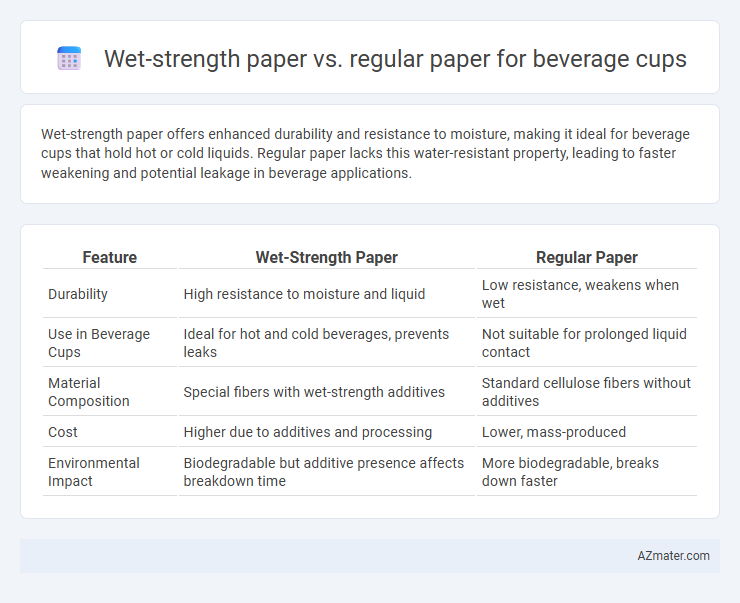Wet-strength paper offers enhanced durability and resistance to moisture, making it ideal for beverage cups that hold hot or cold liquids. Regular paper lacks this water-resistant property, leading to faster weakening and potential leakage in beverage applications.
Table of Comparison
| Feature | Wet-Strength Paper | Regular Paper |
|---|---|---|
| Durability | High resistance to moisture and liquid | Low resistance, weakens when wet |
| Use in Beverage Cups | Ideal for hot and cold beverages, prevents leaks | Not suitable for prolonged liquid contact |
| Material Composition | Special fibers with wet-strength additives | Standard cellulose fibers without additives |
| Cost | Higher due to additives and processing | Lower, mass-produced |
| Environmental Impact | Biodegradable but additive presence affects breakdown time | More biodegradable, breaks down faster |
Introduction to Beverage Cup Materials
Wet-strength paper for beverage cups is engineered with additives such as wet-strength resins to maintain integrity and prevent disintegration when exposed to liquids. Regular paper lacks these enhancements and can easily become soggy, leading to leaks and reduced durability in beverage applications. Choosing wet-strength paper ensures reliable performance, essential for hot or cold drinks, by providing moisture resistance and structural stability.
What Is Wet-Strength Paper?
Wet-strength paper is specially treated with chemical additives such as polyamide-epichlorohydrin (PAE) resins to enhance its durability and resistance to water, making it ideal for beverage cups that contain hot or cold liquids. This type of paper maintains structural integrity and prevents the cup from becoming soggy or collapsing when exposed to moisture. In contrast, regular paper lacks these additives, resulting in reduced performance and potential weakening when used for liquid-containing applications.
Properties of Regular Paper in Cup Production
Regular paper used in beverage cup production typically consists of cellulose fibers with limited wet strength, causing it to absorb moisture and weaken quickly when in contact with liquids. This paper requires additional coatings or lamination to improve water resistance and maintain structural integrity during use. Its lower cost and ease of processing make it a common choice for single-use cups with short-term liquid containment.
Manufacturing Processes: Wet-Strength vs Regular Paper
Wet-strength paper for beverage cups undergoes a manufacturing process that incorporates wet-strength resins, such as polyamide-epichlorohydrin (PAE), to enhance fiber bonding and water resistance, ensuring durability when in contact with liquids. In contrast, regular paper is produced without these additives, resulting in a material that readily loses integrity and strength upon exposure to moisture. The integration of wet-strength chemicals during the paper refining and sheet forming stages creates a robust, moisture-resistant beverage cup suitable for hot and cold drinks.
Water and Liquid Resistance Comparison
Wet-strength paper for beverage cups incorporates chemical resins that significantly enhance water and liquid resistance, preventing paper breakdown and maintaining structural integrity when exposed to moisture. Regular paper lacks these reinforcements, resulting in rapid weakening and potential leakage upon contact with liquids. The improved durability of wet-strength paper ensures reliable containment of hot and cold beverages, making it the preferred choice for liquid packaging.
Durability and Performance in Real-Life Use
Wet-strength paper for beverage cups incorporates chemical additives like polyamide-epichlorohydrin resin, enhancing fiber bonding to resist disintegration when exposed to liquids, resulting in superior durability compared to regular paper. This engineered resistance maintains cup integrity under prolonged contact with hot or cold beverages, reducing leaks, deformation, and material breakdown during real-life use. Regular paper lacks these reinforcements, making it more susceptible to weakening, sogginess, and structural failure, thus limiting its performance for beverage containment.
Environmental Impact and Biodegradability
Wet-strength paper used for beverage cups incorporates synthetic resins that enhance durability but hinder biodegradability and complicate recycling processes, resulting in increased environmental impact compared to regular paper. Regular paper cups, while less durable when wet, break down more easily in natural environments, promoting faster biodegradation and reducing landfill accumulation. Choosing cups with wet-strength additives impacts waste management strategies, often requiring specialized industrial composting to mitigate environmental harm.
Cost Analysis: Wet-Strength vs Regular Paper
Wet-strength paper for beverage cups incurs higher production costs due to specialized resins and coatings that enhance water resistance and durability. Regular paper is more cost-effective but lacks the moisture resistance needed for hot or cold beverages, often leading to structural failure and increased waste. Investing in wet-strength paper reduces replacement rates and leakage-related expenses, offering long-term savings despite the initial higher price.
Suitability for Hot vs Cold Beverages
Wet-strength paper exhibits enhanced durability and moisture resistance, making it highly suitable for hot beverages that generate steam and condensation. Regular paper lacks this reinforced bonding, causing it to weaken and lose integrity when exposed to liquids, especially hot ones. For cold beverages, both wet-strength and regular paper can be used, but wet-strength paper provides superior resistance to sogginess due to its enhanced water tolerance.
Choosing the Right Paper for Your Beverage Cups
Wet-strength paper is engineered with water-resistant resins that enhance durability and prevent weakening when exposed to liquids, making it ideal for beverage cups holding hot or cold drinks. Regular paper lacks these water-resistant properties, often resulting in soggy, compromised cup integrity and potential leaks. Selecting wet-strength paper ensures the cup maintains structural stability and customer satisfaction throughout use.

Infographic: Wet-strength paper vs Regular paper for Beverage cup
 azmater.com
azmater.com